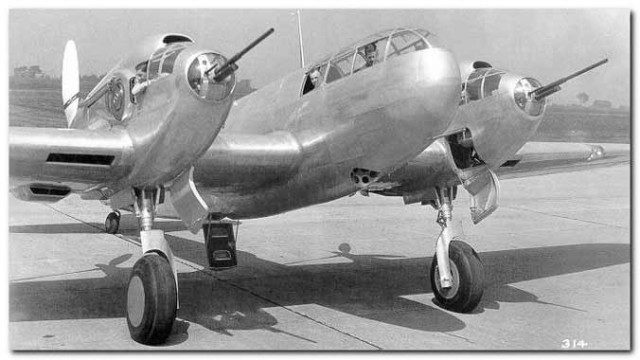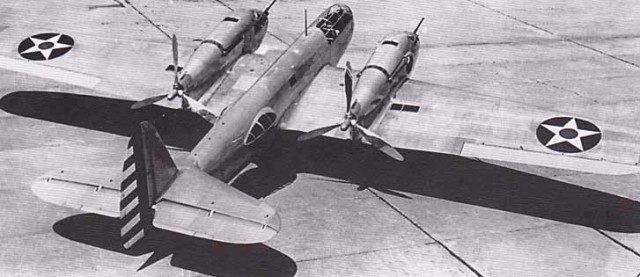Throughout the duration of the test flights for the first FM Airacuda, on the date of September 28th, 1939 one of the turbo superchargers exploded.
The Airacuda was Bell Aircraft’s answer to bomber destroyer aircraft. The innovation of placing an aircrew away from the fuselage was not just a German idea. The Bell Aircuda YFM-1 had almost the same wing mounted crew cabins.
Developed during the late 1930’s for use against enemy bomber formations, the YMF-1 featured manned forward facing gun turrets that were on both wings, each was packing a 37mm cannon. This was to make room for the cabins; the plane’s engines would face the aft.
The first military aircraft produced by Bell, it was originally designated the Bell Model 1. The Airacuda was first flown on September 1st, 1937.

It incorporated several features that had never been seen before in the military aircraft. It was also never seen again. By using a streamlined, “futuristic” model, the Bell Aircuda seemed to be unlike any other fighters that were at that time.
As stated by Major Alexander De Seversky’s book, the Victory Through Air Power, the Bell Aircuda “represents a great engineering achievement. But its designation as convoy fighter is erroneous, since that requires different disposition of armament. With its maximum firepower directed forward, it really offers a preview of an effective long-range interceptor fighter.”
It had been designed during a time when heavy escort fighters like the BF-170 were in the development stages.
The crew of five included the pilot and gunners, with the co-pilot and navigator doubled as a fire control officer.
The radio operator/gunner was armed with a pair of machine guns that were stationed at mid-fuselage waist blister. The purpose of this was to defend against aerial attacks from behind the plane.
A certain unusual feature of the Aircuda had been the main door to enter the plane. The door was able to be opened and pulled down and the hinges folded in on three steps for the crew to be able to climb inside the aircraft.
Ultimately Bell’s FM Aircuda was slower and less maneuverable than the bombers it was supposed to be protecting. This left it useless as an escort fighter.
The Design flaws
The Aircuda was plagued with problems from the start. Regardless of the sleek look it possessed, the Airacuda was heavy and was much slower than most bombers. With the event of interception by enemy fighters, the Airacuda was not able to be maneuverable enough to fight. Meanwhile, the lack of quality of the 270 kg (600 lb) bomb load was not useful for the intended fighter-bomber role. Even the 37 mm cannons were less valued than predicted. The cannons had the tendency to fill the gun nacelles with smoke when they were fired. Additionally, it was feared the gunners would be unable to escape during an emergency. They had propellers directly behind them. That kind of emergency bailout would have required both of the propellers to be feathered.
The Allison V-1710-41 engines, although they were relatively trouble free, had no additional cooling systems.
Like several pusher designs, they were vulnerable to overheating. When it was on the ground, the aircraft needed to be towed to and from the runway and could only be started when the Airacuda was ready for takeoff immediately.
Even while the plane was in the air, it was not uncommon to experience overheating issues.
Even though it was designed for turbo super charging, the first flights were made with V-1710-9 carbureted engines that would only deliver 1,000 hp each.
Regardless of the 5-foot long shaft extensions, there were no issues with that feature. The turbos were later fitted to the YFM-1; they were being plagued by unpredictable regulators that backfired endlessly. An explosion that occurred during the September 1939 test flight made it obvious that the teething engine problems would not be solved with ease.

The other sources that were noted by Marshall Wainwright indicated the first eight aircraft were originally to have been powered by the Allison V-1710-41 engines that were fitted with GE Type B-r turbo super chargers. These aircraft would eventually be delivered with the improved V-1710-23 engines. Wainwright had further stated that two of the YFM-1 air frames were being changed on the production line to accept the V-171041 engine without having to turbo supercharge, turning it into the YFM-1Bs.
This was noted in a contract change that was dated October 19th, 1939, which shows that the aircraft 34-489 and the 38-490 possessed their turbos, all linked ducting, and controls had been removed. The V-1710-41 “Altitude Rated” engines were installed instead. The D2A had been essentially a -23 with escalated supercharger gear ratios. This allowed the motor to develop about 1,090 horsepower that was up to 13,300 ft ASL. They use the exact ratings and components as the Altitude Rated V-1710-33 Allison that was fitted to the original Curtiss XP-40. Allison had been paid $1,690 to be able to modify each engine.
The first test flight that was done by Lt. Ben Kelsey, and proved the Airacuda to be virtually impossible to control with one engine. The aircraft would immediately start spinning.
The problems with stability in pitch were also encountered, and they had to be corrected by reducing the power. Test pilot Erik Shilling described the experiences he had at a later time in the book Destiny: A Flying Tiger’s Rendezvous with Fateas:
“Flying the Bell Airacuda was a new experience for me, since it was the first pusher aircraft I’d ever flown. Its handling characteristics were foreign to anything I had ever had my hands on. Under power it was unstable in pitch, but stable with power off. While flying straight and level, if a correction in pitch was required, a forward push on the control resulted in the airplane wanting to pitch over even more.

Pitch control became a matter of continually jockeying the controls, however slightly, even when the aircraft was in proper trim. The same applied if pulling back on the control. It would tend to continue pitching up, requiring an immediate corrective response. The same happened in a turn with power off, the Bell became stable in pitch.
This was fortunate because during approach and landing, it was very stable, and a nice flying airplane.” – Test pilot Erik Shilling
Later the Airacudas would be dispersed to different airfields so that pilots could fly the old plane and add it to their log books.
The Airacuda had been also saddled with a complicated and temperamental electrical system and was the only aircraft to be ever built to rely on an independent auxiliary power unit that would power both engine fuel pumps, also all aircraft electrical systems. The systems were normally powered by an aircraft engine that was instead powered by a single generator.
The generator had its own supercharger, and was placed in the bell of the aircraft. In the event of failure, the crew had been instructed to start the immediate emergency restart procedures as the aircraft would basically shut down. When the APU would fail, the pilot would not have engines, gear, flaps, hydraulic pressure, vacuum and no fuel pressure.
Despite the aircraft’s countless faults, only two were lost during accidents. The seventh aircraft 38-492 had been on its last test flight from the Buffalo factory prior to delivering to the Air Corps. This is when the pilot John Strickler, who was an engineer and Bell pilot, and the co-pilot Brain Sparks, who had been Bell’s chief test pilot at the time,encountered issues recovering during an intentional spin attempt.
Regardless of every attempt to emerge from the spin, the aircraft was not able to respond, and it seemed that the rudder was locked.
The co-pilot shut down the engines and had waited for the propellers to stop before bailing out of the plane. For the reason of the tandem seating, it had been necessary for Sparks to exit the plane first, and in doing so, he hit the empennage which broke his legs. During the process, the rudder was freed as well. Strickler made the decision to stay with the plane and attempted an emergency landing.
During this point in time, the aircraft had lost sufficient altitude, and there was not enough time to restart the engines.
Strickler had put the Airacuda down hard inside a farmer’s field, and thankfully walked away unharmed. The Airacuda had been damaged so badly that it was scrapped. All three of the Airacudas with tricycle landing gear had encountered issues and were damaged. The more serious accidents happened to the YFM-1A (Model 8) 38-497. This was on the flight from Chanute Field Illinois, to Kessler Field, Mississippi, when a broken oil line had started an in-flight fire. The reason for the broken line seemed to be a serious air frame vibration that was encountered during the flight. Having no way to extinguish the fire, both the crew chief and pilot agreed to bail out.
The pilot had been killed when his parachute failed to deploy, he might have hit the tail while he was bailing out. This would be the only fatality that happened during the test flights of the Airacudas. The reports from the accident investigation stated that the inherent defects in the design caused continual maintenance issues and the flying of this kind is very limited.
The engines were not good, the overheating problem and the pusher props were difficult to master. There were countless other planes to choose from by the time this plane had arrived. The creator Bell had several novel concepts for the time, and this plane was one of them.

The Operational History
Regardless of these issues, one completely operational Airacuda squadron was sooner or later assembled, and was operated from 1938 up until the year of 1940. The funds were available, yet never released, this was for the purchase of the two groups of Airacudas. The continuous issues gave the plane a reputation as the hangar queens.
At the end of the type’s operational life, the aircraft had been flown mainly for photo opportunities and were always followed by a chase plane for safety.
The Airacudas were sent at different times to Dayton Ohio, Wright Field, California, Hamilton Field, Maxwell Field, Virginia, and in Langley Field. The YFM-138-388 appeared at the 1940 World’s Fair that was in New York. Throughout this time, the plane saw limited flight time, as a few pilots were interested in flying the unusual plane.
Countless plans were made to alter the Airacudas to give them an operational status; this included changing the air frame and adding engines that were more powerful.
Yet all of the proposals were sooner or later rejected. During the early part of 1942, regardless of the fears with the enemy bomber attacks that were against the Airacuda had been intended, the planes were stricken from the inventory.
